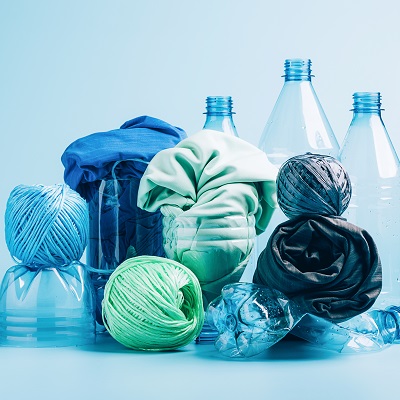Today, sustainability is no longer new to our daily lives. In recent years, this term has made its way into a wide variety of fields like chemistry, biology, law, economics, architecture, management, and more. However, the deepest meaning of "sustainability" has undergone an evolution driven by several factors, first and foremost, the growing consciousness of the need to establish principles and instruments to make it a reality. The number of internet searches related to the term has increased since 2014, as well as social discussions around the topic. The subject has become so mainstream that it now seems (almost) commonplace and obvious to hear about. Sustainable development is an important topic on the agenda of several industries, including Fashion.
This is good news since, even today, the fashion industry is responsible for about 10% of CO2 emissions and is the fourth-highest consumer category in the European Union for water consumption and primary raw material use. Along with governments, states, and citizens, companies are also being called on to play their part, and the European Union's efforts in raising business awareness of safeguarding the planet are steadily growing. The 2030 Agenda and the 17 Sustainable Development Goals are proof of this, as well as the concept of Social Corporate Responsibility introduced by the European Commission in 2001 and defined as "the voluntary integration of companies' social and ecological concerns into their business operations and their relations with stakeholders." A challenge with clear intentions: integrating social development and environmental protection programs into the roadmap of business objectives.
People often believe that the solution to global challenges concerns only large companies. Indeed, regardless of size, every company is part of a globalized ecosystem from which it draws to store resources (not just economic ones) to carry on its business. Everyone, then, can make a difference, and today, thanks to technological innovation and research, companies can count on various possibilities and alternatives to incorporate sustainability into their daily activities, thus contributing to the generation of value for the company and the planet in the long run.
The fashion industry, whose supply chain impacts 90% of the environment, has good alternatives, including biodegradable, regenerated textile fibers or those derived from waste materials.

This is the case of Orange Fiber, a young Sicilian start-up that has made a type of fabric by recovering residues produced by citrus farms, or Apple Skin - a vegan leather made in Italy. As a final point, it is not necessary to use innovative raw materials; lots of times, it is enough to use different processing techniques, for example, fabric dyeing techniques that use less water or innovative dyeing techniques using bacteria.
The proliferation of generic statements and claims such as green, ethic, and environmentally friendly that, when not backed up by real data, cause false expectations and create misunderstandings over time, leading to a growing suspicion of greenwashing among consumers and a loss of credibility for companies. Industries, including Fashion, have a responsibility towards their customers, which is to perform acts of honesty by communicating correctly and transparently their commitment regarding the sustainability issue.
Moreover, companies must always keep in mind that sustainable development is not only about saving the planet, but it is also, and perhaps above all, an important social and governance issue. The initial frenzy and lack of solid guidelines on communicating sustainability somewhat ruined the game for everyone, probably without even realizing it. Greenwashing often occurs because of inaccurate and partial communication rather than a genuine intention to deceive the consumer. No more time to waste; we need to earn consumers' trust and continue to cherish it.
There are two main types of thinking about sustainability: the first is problem-oriented, and the second is solution-oriented. On social media, people are much more likely to participate in conversations about solutions, which represent, in fact, 77% of total conversations on the topic. Under this historical phase, which is characterized by the feeling of disillusion, the protest methods carried out by climate activists often turn out to be extreme and out of place, to the point of provoking anger and disgust in front of setting like blocked streets or damaged works of art. However, these actions infused with negative emotions, such as fear of the future, uncertainty, or arrogance, do not motivate the consumer to act; on the contrary, they cause them to feel guilty.
Nevertheless, this is only one of the latest motivators in the push toward sustainable choices and behaviors. On the contrary, the comfort we perceive when we perform a simple gesture, such as avoiding running water while brushing our teeth, or using biodegradable dishes during a picnic, is the result of a positive feeling, i.e., hope, which inspires action. According to some research completed by Pulsar Trac, hope is one of the strongest and most relevant motivators driving people to take sustainable actions.
Climate change has clarified that our consumption patterns cannot work much longer. According to a study by the EEA (European Environment Agency), garments, footwear, and textiles represent the fourth highest consumption category in the EU regarding water, land, and energy use, after food, housing, and transportation. Luckily, given this evidence, consumers are increasingly aware and demanding. They are not only looking for beautiful clothes to wear but for clothes and accessories produced without jeopardizing the planet's conditions and the safety of employees. People are also much more careful about waste, garbage management, and over-production problems.

Every year the total production volumes of the fashion industry increase by 2.7%. Among fashion labels, there is an increasing acknowledgment that a change is necessary, and several brands have committed to promoting meaningful transformation, even though the path still needs to be clarified. Indeed, the fashion industry made some progress ten years after the Rana Plaza tragedy. Still, the pressure for a more respectful supply chain that protects the planet's balance and workers' well-being is growing. Sustainable fashion fits well into a broader concept of a sustainable society: yes, because sustainability is, first and foremost cultural, and people drive culture.
We at Deda Stealth recently attended the PI Apparel Supply Chain Forum in Amsterdam, an event entirely dedicated to the fashion supply chain. Even from the partners present with their booths, it was easy to guess the priority of this historic moment for the Fashion industry: all the proposed solutions were aimed at supply chain management in various connotations, from traceability to collaboration and integration.
As part of the event, we also had the opportunity to hold a Think Tank. Through the comments and contributions made by the participants, we discovered that in some countries, there is specific legislation coming up that we in Italy still hear little about. While these regulations are currently domestically confined, they are always designed to improve the traceability and sustainability of the supply chain of products sold in different European countries. So, it is important to be informed and prepared when the time comes to comply with these standards and legislations. There is great interest and a widespread understanding of the issues in the industry, which is an excellent indicator of the importance of these issues to the fashion industry. However, several challenges await fashion brands, and there is still a long way to go. 2030 is not that far away, and time should be well-spent.
From reusing to repairing and recycling, the principles of the circular economy represent the future of fashion (and beyond) and the most reliable answer for the next generation's well-being. The circular economy, in contrast with the linear model, is a system that aims to reduce waste and trash by reintroducing materials and items back into the production cycle at the end of their life span. The belief behind this model is that everything is born to live multiple lives.
Since the 1970s, the Global Footprint Network organization has been calculating Earth Overshoot Day - that is, the date when, each year, humanity finishes consuming all the resources produced by the planet annually.
This year's Earth overshoot day has been predicted for August 2nd. Meaning that, on that date, we will run out of the resources that our planet can produce in one year, and therefore for the remaining time in 2023, we will be "borrowing" resources from the following year, basically as if we had one and a half planets instead of one.
Circular economy fits into this context as one of the possible solutions, and significant contributions are coming from governments worldwide, especially in the fashion industry. Starting from January 2022, the obligation to collect textile waste separately has been introduced in Italy, a law that will come into effect by 2025 at the European level as well. These initiatives aim to facilitate the reuse and recycling of waste to slowly get to the point where waste is reduced to the bare minimum. Other legislative and regulatory initiatives address the two enabling factors for the circular economy: transparency and traceability.
The AGEC law in France aims to transform linear economic models into circular economy systems and is applied in several areas of intervention: decreasing the use of plastics; punctually informing consumers; reducing waste in favor of recycling; making the production chain more transparent and traceable. On the other hand, the Kreislaufwirtschaft (German Circular Economy Act) directive focuses mainly on separating and recycling industrial and household waste. Finally, introducing the Digital Product Passport (DDP) will change the management and retrieval of product information, supporting the principle of data economy.
The European Commission wants to accelerate the circular transition, following up on the goals set by the Green Deal. The DPP will provide information on the composition of products circulating on the European market to increase the possibilities for reuse or recycling.

According to the new regulation, the product passport will:
The idea is to provide supply chain players with all the data they need to understand better how to dispose of waste or give products new life properly. Probably the DPP could finally highlight the many cases of "False Green Claims," better known as Greenwashing cases, helping consumers orient their purchasing choices and consistently rewarding those production realities that, with so much commitment and determination, try to embrace circularity and sustainability logics.
There are already virtuous examples to be inspired by. A few months ago, I had the good fortune to visit the production plant of a Tuscan company. It has been quite a source of hope for the industry's transformation. The company's core business is woolen garment production, but it also devotes part of its activities to textile production. This Tuscan business was born during World War II when there was a need for new garments, but there needed to be more raw materials. The special feature is not to use virgin raw materials but rather the production or textile waste, collected and sorted by color and composition.

Wool (as well as some other natural materials) has a solid regenerative capacity. Its fibers are strong and flexible enough to withstand not only years of use but also 100 percent recycling (and multiple times). A unique process was created to destroy the used garment, create a "recipe" of color and mix wool fibers of various shades to achieve the desired result of the new yarn. This is an ingenious vision: not only is virgin wool preserved, but the massive amount of water needed to dye the yarn is saved.
This logic of circularity, for example, has been applied for years in the furniture industry: starting from the similar need to make maximum use of scarce resources and produce excellent results. Eventually, the scarcity of resources can be an opportunity and sharpen one's genius.
Circular economy can only be part of the long-term solution because even if this approach considers future waste, it does not prevent it. The volume of textile waste is huge, although consumers often struggle to perceive it. Donations of clothing made in the global south usually do not get to be reused for three main reasons:
Most textiles used today are not of natural origin. Therefore, they alone can never be assimilated by the environment. At the same time, however, if recycled at the end of its life, it requires the most minor consumption of resources (compared to production from scratch). In addition, we must always consider the complexity behind an "organic" production approach because cultivating cotton, a natural fiber, requires very high-water consumption and uses a lot of land. So, while being natural, it does not guarantee zero impact. Furthermore, another aspect concerns synthetic fibers: nowadays, there is no complete knowledge of any technique for recycling them, nor for making these fabrics less harmful to the environment (e.g., depolymerization that prevents the release of microplastics).
Whether it is because of high costs, or the difficulty of sourcing low-impact raw materials, circularity can be challenging to implement. Moreover, focusing exclusively on the end-of-life of garments is not enough because circularity requires a holistic approach that starts upstream in the value chain, that is, to make the product have a second life, and already at the design stage, it is necessary to consider this aspect. A product itself can never be called "sustainable" if it follows a business model that is not. The increase in circularity cannot be directly proportional to the rise in production. Still, on the contrary, it must make up for the excessive use of the available resources. At the same time, it cannot be an excuse to continue producing as before ("we recycle it later anyway").
One of the 5Ps of the 2030 Agenda goes under the heading Partnership.
To realize and enhance the best practices of sustainable development and the green economy in the best possible way, continuous discussion among the various stakeholders in the chain is necessary.
The new priorities of agility, transparency, traceability, and continuous dialogue touch various parts of the Supply Chain. This is precisely where the need for a single ecosystem comes from, one that allows the exchange of information, approaches, and inspirations that all lead to the same goal: to build business models in line with the needs of sustainability to preserve the planet.
Deda Stealth, for instance, is part of the Monitor for Circular Fashion, an active, concrete, and diversified community with the values of collaboration and sharing at its core, promoted by SDA Bocconi School of Management in Milan. Participants in the project include brands, manufacturers, suppliers, and standards consultants for industries and technology providers. While there is usually a form of competition among fashion players, overcoming the challenge of climate change requires everyone to work together and share best practices and knowledge.

The Monitor complements the classroom plenaries with a traveling itinerary that allows each member to deepen and better understand the realities of other players and share sectoral issues and propose sustainable solutions. In addition to the continuous exchange of information and approaches, there is a concrete attempt to include the practices of traceability and circularity in the companies. Several pilot projects have been implemented in recent years, applying the principles of traceability and circularity and demonstrating that the industry can be transformed. The challenge in the coming years is to make these pilot projects industry-approved.
The urgency of transformation is, by now, clear. The industry needs an evolution of procurement processes and, not least, internal operations as well. We are indeed talking about a complicated and ambitious challenge. Still, with technological development and digitalization support, companies can apply less resource-consuming production models and incorporate traceability and transparency practices into their supply chains.
At Deda Stealth, we closely observe the market's sustainability needs, creating optimized solutions for supply chain traceability and transparency. There is undoubtedly still a long way to go for the fashion industry. Still, we have already accepted this challenge and want to support this much-needed change with other qualified partners and entities.
Technological innovation can and must necessarily be an active part of the solution, along with the industry's transformation.